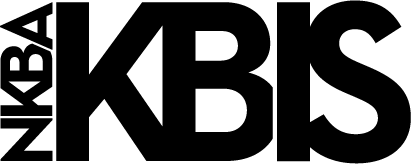After living in their 1980s Florida ranch home for nearly 20 years, a couple decided it was time to trade their dated primary bath, which was open to the bedroom, for a more contemporary space. Instead of the tiny original shower that shared the toilet room and a massive garden tub with a carpeted deck, the homeowners sought a welcoming layout and put easy maintenace at the top of their list. They called on Brooke Eversoll, CMKBD, CEO and principal designer of St. Petersburg-based Bee Studios, to transform the dingy bathroom into a modern coastal space with uncomplicated cleanability.
The main part of the project was opening and adjusting the layout, which led to several challenges during the build phase because the house is block construction, and the bathroom is located adjacent to three exterior walls.
Design Challenge #1 – Layout Restrictions
In this awkward space, Eversoll had a lot with which to contend. The bathroom abutted a central closet with an angled wall that limited space for all areas. The adjacent bedroom ceiling was pitched, and there was no door into the bathroom. There was a skylight in the shared toilet and shower room, and the tub sat in a corner with big windows.
The skylight and corner windows would stay in place, and Eversoll had to plan a new layout around them. She began by reshaping the room’s perimeter from the inside.
“We squared up the interior closet wall, gave them a proper walk-in closet and added a door to the entry of the bathroom,” said the designer. “Making sure the skylight fell within a space that was logical was a challenge.”
Replacing the massive tub and deck with an elegant freestanding unit freed up some space to add shelves and a tall cabinet on the interior wall, gaining storage the previous bathroom lacked.
Challenge #2 – Poured Concrete Complications
Eversoll wanted to take over the toilet and shower room for a zero-entry shower, so she planned to shift the toilet back and turn it 90 degrees. That kept the skylight in the shower ceiling where it would have the most benefit. In the enclosed water closet, a new wall-hung toilet meets the clients’ request for cleanability and privacy.
But when the plumber opened the concrete slab to relocate the drain for the toilet, an oversized footer would not allow the plumbing to be run that close to the exterior wall. Instead, they added a pony wall inside the toilet room to provide the space to house the in-wall toilet tank.
“We had to pad out the knee wall that housed the wall-hung toilet components farther than expected,” said Eversoll. “It could have been an issue, but with a little onsite problem-solving, it turned out fine.”
Wrapped in marble-look porcelain tile, the knee wall brings flair and cleanability to the toilet room and is deep enough to double as a shelf. A similar situation occurred when installing the wall-mounted faucets above the vanity, which were also intended to fulfill the clients’ request for easy cleaning. Like the toilet wall, the one behind the vanity is a concrete exterior wall, so a bump out was added behind the cabinetry to accommodate the faucets.
“It required a bit of work among contractor, framer and electrician, but it gave the clients a ledge they love,” said the designer. “It was a happy accident.”
Design Challenge #3 – Mistaken Measurements & the Supply Chain
Using larger-format porcelain wall tile in this bathroom was part of meeting the clients’ need for a space that would be easy to clean. Although Eversoll planned for the typical overage with the tile order, it was not nearly enough for the room’s many walls, mitered turns, shower bench and knee walls. The ceiling height was also a true 96 inches, but the tiles were a nominal 24 by 48 inches — the actual dimensions were 23-1/2 by 47 inches. To stack the tiles to the ceiling, the team needed five rows of tile instead of four as originally planned.
“Typically, tile is listed as a nominal size, but you need to get the true and actual dimensions,” said Eversoll. “It’s imperative in planning, especially when you have really tiny grout lines and lots of smaller walls.”
She had to put in an extra tile order, but because the project installation took place during the midst of the COVID-19 pandemic and the tile came from Italy, the vendor did not have it stocked in the U.S. She split the cost of a fast air freight delivery from overseas with her clients – waiting would have pushed the whole project back.
The tile emergency was the biggest lesson Eversoll learned from this project. She now recommends ordering considerably more tile than estimated for large-format tiles and expecting more waste. It is good practice to check this with the tile installer, too.
“There are always things you have to adjust in the field,” she said. “Nothing that came up was catastrophic, and we never lost the design intent.”
—By Carrie Whitney








